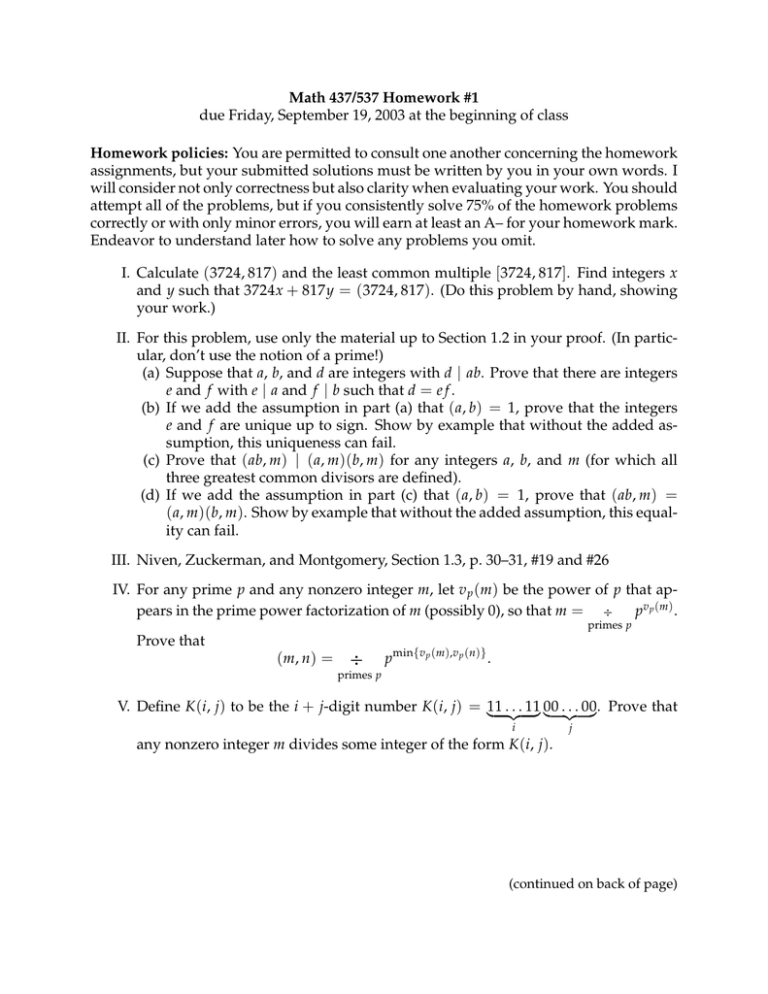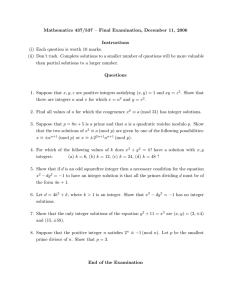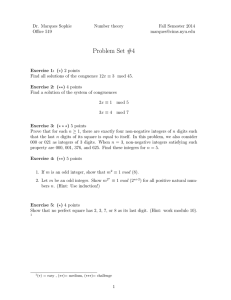Math 437/537 Homework #1 Homework policies:
advertisement

Math 437/537 Homework #1
due Friday, September 19, 2003 at the beginning of class
Homework policies: You are permitted to consult one another concerning the homework
assignments, but your submitted solutions must be written by you in your own words. I
will consider not only correctness but also clarity when evaluating your work. You should
attempt all of the problems, but if you consistently solve 75% of the homework problems
correctly or with only minor errors, you will earn at least an A– for your homework mark.
Endeavor to understand later how to solve any problems you omit.
I. Calculate (3724, 817) and the least common multiple [3724, 817]. Find integers x
and y such that 3724x + 817y = (3724, 817). (Do this problem by hand, showing
your work.)
II. For this problem, use only the material up to Section 1.2 in your proof. (In particular, don’t use the notion of a prime!)
(a) Suppose that a, b, and d are integers with d | ab. Prove that there are integers
e and f with e | a and f | b such that d = e f .
(b) If we add the assumption in part (a) that ( a, b) = 1, prove that the integers
e and f are unique up to sign. Show by example that without the added assumption, this uniqueness can fail.
(c) Prove that ( ab, m) | ( a, m)(b, m) for any integers a, b, and m (for which all
three greatest common divisors are defined).
(d) If we add the assumption in part (c) that ( a, b) = 1, prove that ( ab, m) =
( a, m)(b, m). Show by example that without the added assumption, this equality can fail.
III. Niven, Zuckerman, and Montgomery, Section 1.3, p. 30–31, #19 and #26
IV. For any prime p and any nonzero integer m, let v p (m) be the power of p that appears in the prime power factorization of m (possibly 0), so that m = ∏ pv p (m) .
primes p
Prove that
(m, n) =
∏
pmin{v p (m),v p (n)} .
primes p
V. Define K (i, j) to be the i + j-digit number K (i, j) = 11
. . 11} 00
. . 00}. Prove that
| .{z
| .{z
i
j
any nonzero integer m divides some integer of the form K (i, j).
(continued on back of page)
VI. (a) Let p be an odd prime and r a positive integer. Let { a1 , . . . , aφ( pr ) } be a reduced
residue system modulo pr . Prove that a1 × · · · × aφ( pr ) ≡ −1 (mod pr ).
(b) Let p be any prime and r a positive integer. Write ( pr )! = kps , where k and s
are integers and p - k. Determine (as functions of p and r) both s and the least
nonnegative residue of k (mod p). (The least nonnegative residue of n (mod m)
is the unique integer ` with 0 ≤ ` < m and n ≡ ` (mod m).)
VII. Find the last three digits of the integer 987(1203
it or not, this one can be done by hand!)
321 )
. (Hint: Euler’s Theorem. Believe
VIII. Niven, Zuckerman, and Montgomery, Section 2.1, p. 57–59, #20, #27, and #48
IX. (a) Which integers x satisfy all of the congruences x ≡ 3 (mod 14), x ≡ 5 (mod 15),
and x ≡ 7 (mod 17) simultaneously?
(b) Find the smallest positive integer n such that 2n ≡ 3 (mod 5), 3n ≡ 4 (mod 7),
4n ≡ 5 (mod 9), and 5n ≡ 6 (mod 11). Hint: there’s a painless way.








